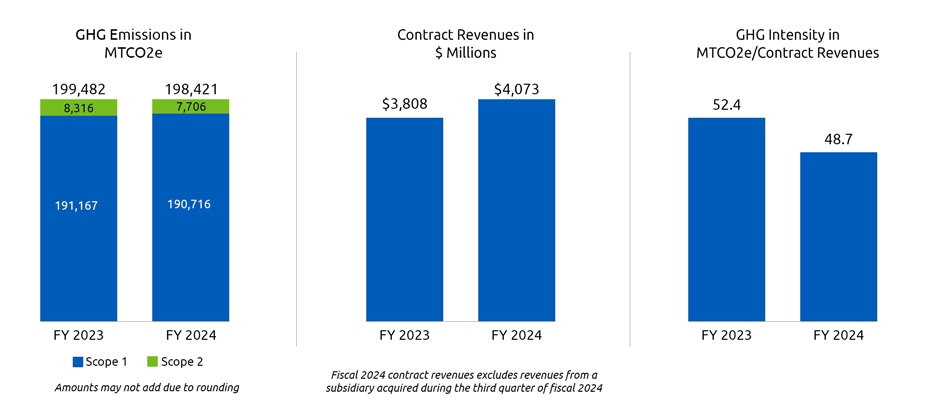We are accountable
We are committed to regularly measuring and evaluating opportunities to reduce our environmental footprint both short-term and long-term. We embrace the latest technology and continuously optimize our core business practices.
Our Environmental Footprint
Our emissions are directly correlated to business volumes and fluctuations each year. We assess our Scope 1 and Scope 2 greenhouse gas (GHG) emissions impact based on a GHG intensity rate that compares absolute emissions in metric tons CO2e to annual contract revenues (in millions) over the same period.
Dycom is committed to continued enhancement of data collection efforts and reporting of GHG emissions. We expanded our GHG inventory to include Scope 2 GHG emissions from electric vehicles for fiscal 2024. The information presented below for Scope 1 and Scope 2 GHG emissions and GHG intensity (collectively, the “metrics”) for fiscal 2023 and 2024 was subject to internal review and external independent third-party limited assurance. The metrics include Dycom and its wholly-owned subsidiaries, except for the reporting data for a subsidiary acquired during the third quarter of fiscal 2024.
GHG intensity decreased to 48.7 for fiscal 2024 compared to 52.4 for fiscal 2023, resulting from a decrease in absolute Scope 1 and Scope 2 emissions on an increased level of operations. This improvement was primarily driven by continued investment in upgrading our fleet and equipment with newer, more fuel-efficient models that contributed to a reduction in total fuel consumption.
Dycom considers the principles and guidance of the World Resources Institute (WRI) and the World Business Council for Sustainable Development’s (WBCSD) The Greenhouse Gas Protocol: A Corporate Accounting and Reporting Standard, Revised Edition, and GHG Protocol Scope 2 Guidance: An amendment to the GHG Protocol Corporate Standard (together the “GHG Protocol”) to guide the criteria to assess, calculate and report direct and indirect GHG emissions. Emission sources for fiscal 2023 and 2024 include mobile combustion (on and off-road vehicle fleet and private aviation fleet), stationary combustion (natural gas, heating oil, and heating propane), and electricity utility data for all sites and fleets under operational control.
We understand the importance of tracking and managing climate related matters, including greenhouse gas emissions. We continually evaluate metrics and targets that will enable us to assess climate related risks and opportunities in line with our strategy and risk management process.
We continue to implement processes and procedures to enhance tracking and reporting within our operations as we develop a roadmap for reducing emissions.
Our Fleet
Our fleet is essential to delivering for our customers, but we recognize that it also contributes meaningfully to our carbon footprint. We have invested in several initiatives that reduce our current fleet’s fuel consumption and related emissions.
- Fleet management, we maintain a late-model fleet to ensure that fuel-efficient vehicles are in service
- Route optimization, we optimize the routing of our trucks using telematics to efficiently serve customers
- Idle management, we monitor idle time in all vehicles using telematics and we equip all diesel vehicles with auto-idle shutdown
- Fleet electrification, we are in the midst of a pilot program to bring electric trucks into the field
Opportunities in Green Technology
At Dycom we believe in continuous improvement, assessing opportunities that help us drive advancements in our work while simultaneously supporting sustainability.
Fleet
We are currently piloting a program to bring electric trucks into the field. This program will allow us to evaluate the best way to integrate electric vehicles more widely into our fleet. We are partnering with a major auto manufacturer to pilot their new, all-electric truck in the field.
Equipment
We are evaluating and assessing opportunities to electrify our equipment by replacing many of our 2-cycle gas-powered handheld tools with battery-powered alternatives.
Waste Management
While our operations do not generate a significant amount of waste, we continue to evaluate ways to operate more efficiently and minimize waste across our work sites and offices.
On-site Waste
- We have transitioned many paper-based practices to digital practices including digital records for all field employees. As well, our safety group has transitioned to a paperless format for all communications and reporting.
- We have introduced recycling programs for on-site materials.
- We have begun purchasing equipment with rechargeable Li-Ion battery packs instead of using Alkaline batteries for cordless tools and equipment.
Office Waste
To reduce office waste, we have embraced a paperless office concept. We have selected Amazon’s AWS cloud to support our digitization efforts. We have moved over 99% of our server capacity to the AWS cloud. AWS has committed to powering its platform with 100% renewable energy by 2025, which will help us further reduce the environmental impact of our own operations.


